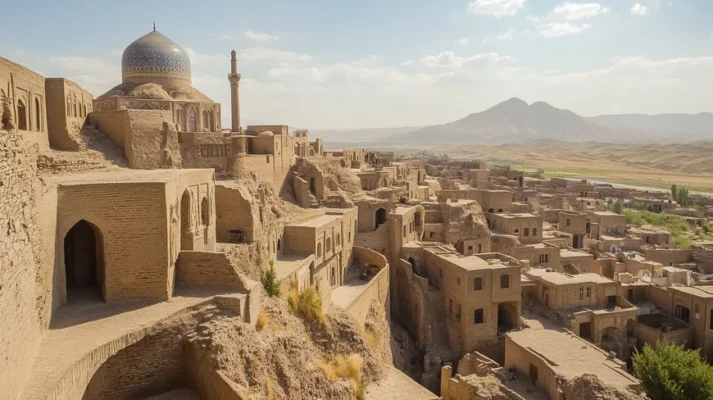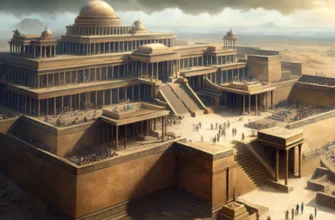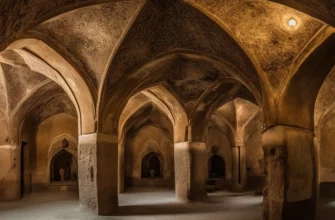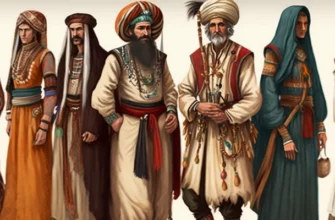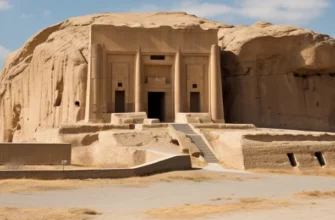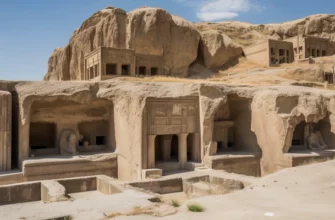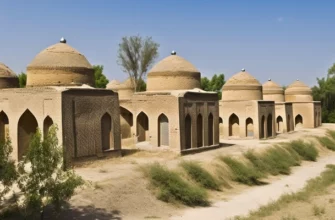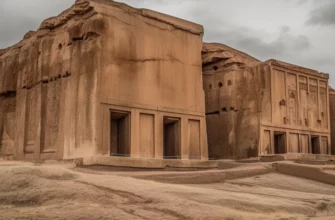Dinavari is one of the oldest cities in Iran, located in the west of the country, in the historic region of Kermanshah. In the Middle Ages, this city was an important center of culture, science, and Islamic theological thought. Its heyday came during the Abbasid Caliphate, when Dinavari became a center of education and scientific research.
Historians believe that the city originated in the pre-caliphate era, but it became most famous in the 8th–10th centuries. It was here that the outstanding scientist and geographer Al-Dinaviri was born and worked, leaving a significant legacy in the fields of history, botany, and astronomy.
Archaeological research confirms that Dinavari had a well-developed infrastructure: mosques, madrasas, bazaars, and water supply systems. Unfortunately, the city was destroyed during the Mongol invasion in the 13th century and never regained its former importance.
Today, the ruins of Dinavar are a valuable archaeological site that preserves traces of its great past. Despite its decline, the city remains an important page in the history of Iran and Islamic civilization.
Dinavar was located in the west of modern Iran, within the historical province of Jibal, near the modern city of Kengavar in the province of Kermanshah. The city lay on an important trade route connecting the western lands of Iran with the central regions and Mesopotamia. Thanks to this location, Dinavar played a significant role in trade, the spread of knowledge, and cultural exchange between the East and West. Surrounded by the Zagros Mountains, the city was of strategic and economic importance in the region.
History of Dinavar
Dinavar has deep historical roots dating back to pre-Islamic times. During the Sassanid era, the city was already an important administrative and commercial center. After the Arab conquest of Iran in the 7th century, Dinavari quickly adapted to the new conditions and became an important center of Islamic culture and science.
In the 8th–10th centuries, during the Abbasid Caliphate, Dinavari reached its peak. The city was known for its numerous schools, libraries, and scholars. It was here that the famous scholar Al-Dinavari, a historian, geographer, and botanist, lived and worked. His work, Kitab al-Ahbar al-Tival, became an important source of knowledge about history and nature.
In the 13th century, the city was severely damaged during the Mongol invasion. After that, Dinavari lost its political and scientific significance and gradually declined. Only the remains of ancient buildings and fragments of archaeological sites have survived to this day, testifying to its glorious past.
Foundation and first mentions
The exact date of Dinavar’s foundation is unknown, but its emergence is attributed to the pre-Islamic period of Iran, probably to the Sassanid era (3rd–7th centuries). The city may have served as an administrative center in the Jibal region due to its strategic location at the crossroads of important trade routes.
The first written references to Dinavar appear in sources from the early Islamic period. Arab geographers and historians, including al-Baladhuri and al-Ya’qubi, mention the city as an important center within the Muslim caliphate.
According to these descriptions, Dinavari was already famous for the education of its inhabitants, the presence of educational institutions, and cultural activity.
Its importance in the region only grew after Islamization, and by the 8th century, the city had become known as a center of science, where a new generation of scientists, thinkers, and theologians was formed.
Periods of prosperity
The most famous period of Dinavari’s prosperity is considered to be the 8th–10th centuries, when the city became an influential center of culture, science, and religious education within the Abbasid Caliphate. At that time, the city had madrasas, libraries, scientific circles, and its scholars were respected throughout the Islamic world.
Dinavari experienced a particular upswing thanks to the activities of thinkers such as Abu Hanifa Ahmad al-Dinaviri, who made the city famous with his works on history, geography, astronomy, and botany. This turned Dinavari into the center of intellectual life in the Jibal region.
The city’s economic boom helped crafts, trade, and agriculture grow. Because it was at the crossroads of trade routes, Dinavari attracted merchants, travelers, and scholars from different parts of the caliphate.
Throughout these centuries, the city was supported by local rulers who encouraged the development of education and science. This golden age of Dinavara ended only in the 13th century after the Mongol invasion, which led to the gradual destruction of the city’s infrastructure and the decline of scientific activity.
Destruction and decline
The period of decline of Dinavaru began in the 13th century, when the city suffered a devastating invasion by Mongol troops led by Hulagu Khan. Like many other cities in Iran, Dinavaru suffered massive destruction — buildings were destroyed, libraries were burned, and a significant part of the population was killed.
This tragedy was a turning point in its history.
After the invasion, the city was unable to fully recover. Economic and cultural life gradually declined, and it lost its role as a scientific and educational center. Most scholars and residents left the city in search of safer places to live and work.
In the following centuries, Dinavaru turned into a provincial settlement and eventually disappeared almost completely from the political map of the region. Only ruins and isolated mentions in historical sources reminded of its former glory.
Today, the archaeological remains of Dinavar are a valuable historical testimony to the city’s greatness during its heyday and tragic decline.
Cultural and scientific significance
During its heyday, Dinavar was one of the leading intellectual centers of Iran and the Islamic world. Thanks to favorable conditions and the support of local authorities, various fields of knowledge flourished here, including history, geography, astronomy, botany, philosophy, and Islamic theology. The city was famous for its schools, libraries, and madrasas, which attracted students and scholars from all over the caliphate. One of the most influential figures associated with Dinavar was Abu Hanifa Ahmad ibn Daud al-Dinaviri, an outstanding scholar of the 9th century.
In his work Kitab al-Ahbar al-Tival, he combined historical narrative with geographical descriptions, and his Book of Plants (Kitab al-Nabat) is considered one of the first scientific works on botany in the Islamic world. Thanks to such scholars, Dinavari gained a reputation as a city of knowledge.
In addition to its scientific activities, Dinavari was a center of cultural exchange where Persian, Arab, and local traditions intersected. The local intelligentsia actively participated in the formation of Islamic philosophy, jurisprudence, and literature.
Thanks to its contribution to the development of science and culture, Dinavari took its rightful place among the great cities of the Islamic Golden Age, such as Baghdad, Basra, and Nishapur.
Notable figures
Dinavari gave the world several outstanding thinkers, the most famous of whom is Abu Hanifa Ahmad ibn Daud al-Dinaviri (9th century). His name has become a symbol of the city’s scientific heritage.
Al-Dinaviri was a universal scholar — a historian, geographer, mathematician, astronomer, and botanist. He authored important works, including:
Kitab al-Akhbar al-Tival (The Book of Great Stories) — one of the first Islamic historical treatises, covering the history from the creation of the world to the time of the Caliphate;
Kitab al-Nabat (Book of Plants) — a comprehensive work on botany that combines scientific observations with folk knowledge about plants.
Thanks to these works, Al-Dinaviri is considered one of the pioneers of the scientific method in the Muslim scientific tradition.
Other lesser-known but important figures associated with Dinavari were theologians, linguists, and poets whose names appear in medieval biographical dictionaries. Their works preserved cultural continuity and contributed to the spread of knowledge in the Jibal region.
Thus, the intellectual heritage of Dinavari was largely determined by the activities of its scholars, who made the city an important part of the scientific world of the Islamic Middle Ages.
Al-Dinavari and his contribution
Abu Hanifa Ahmad ibn Daud al-Dinavari (9th century) is one of the greatest figures in the history of scientific thought in medieval Iran. Born in Dinavari, he became famous for his works on history, geography, astronomy, botany, and the Islamic scientific tradition. His works had a significant influence on the development of science in the Arab world and beyond Iran.
One of Al-Dinaviri’s major works is Kitab al-Akhbar al-Tawil (The Book of Great Tales), which covers history from the creation of the world to the early periods of the Islamic Caliphate. In this work, he combined not only historical facts, but also religious, social, and cultural aspects that allow modern researchers to better understand the historical context of that time. His work was one of the first systematic descriptions of early Islamic history.
Al-Dinaviri is also known for his “Book of Plants” (Kitab al-Nabat), in which he described plants, their properties, and their use in medicine and agriculture. This work became the basis for further research in botany and pharmacology, and also preserved a wealth of folk knowledge about the plant world passed down through generations.
In astronomy, Al-Dinaviri contributed to the study of celestial phenomena and compiled descriptions of various astronomical phenomena that were of great importance to scientists and astronomers of the time.
Thanks to his works and achievements, Al-Dinaviri became not only a scientific authority of his time, but also a symbol of the intellectual heritage of Dinavari. His contribution to the history of science made him one of the key figures in Islamic science, who continues to inspire researchers today.
Archaeological finds
Archaeological excavations in Dinavari began in the 20th century and continue today, revealing much of its grandeur in ancient and medieval times. Among the artifacts found are numerous evidence of the cultural and scientific development of the city.
Ruins of ancient structures:
Archaeologists have discovered the remains of walls, columns, and parts of buildings dating back to different periods. These include the remains of mosques, madrasas, as well as residential and administrative buildings, which testify to the city’s high level of infrastructure and architectural culture. The ruins of these buildings provide important information about the style and techniques of construction prevalent in medieval Iran.
Written artifacts:
Important finds include fragments of ancient manuscripts that provide evidence of the literary and scientific level of Dinavaru. Parts of texts written in Arabic and Persian testify to the high level of education and cultural exchange between Iran and the Arab world.
Everyday artifacts:
Among the finds are ceramics, tools, metal objects, and household items that allow us to reconstruct the daily life of the city’s inhabitants. Excavations have uncovered numerous examples of ceramics with ornamentation characteristic of the local style and manufacturing techniques.
Places of worship and religious objects:
The remains of temples and religious buildings have also been found, confirming the importance of religion in the life of Dinavaru. These finds help researchers reconstruct religious practices and the influence of different cultures, including Zoroastrianism and Islam.
Architectural elements and decorative details:
An important discovery is the architectural elements, including the remains of decorative tiles, bas-reliefs, and carved stones, which demonstrate the high level of skill of local craftsmen.
These archaeological finds not only provide a better understanding of the history and culture of Dinavari, but also help to reconstruct what one of Iran’s largest and most important cities looked like during its heyday.
Main excavations
Archaeological excavations in Dinavar began in the late 20th century, and since then, several important discoveries have been made that provide a deeper understanding of the history and culture of this ancient city.
Excavations in the area of the ancient city: The main excavations in Dinavar focus on studying the remains of city walls and buildings from different periods. Parts of the ancient walls that once surrounded the city have been uncovered, as well as fragments of important administrative and religious buildings. These include the remains of mosques, madrasas (Islamic schools), and residential buildings.
Excavations in the large bazaar: Excavations carried out in the ancient bazaar of Dinavari are also important. Here, archaeologists have found numerous everyday objects, from metal tools to ceramics, which allow us to reconstruct the commercial life of the city during its heyday.
Archaeological excavations at religious sites: Of particular value are the excavations carried out on the territory of temples and religious buildings associated with the religious practices of the inhabitants of Dinavaru. Among the finds are the remains of ancient temples, cult statues, and religious artifacts that testify to the importance of religion in the life of the city, in particular Islam and, possibly, Zoroastrianism.
In-depth excavations of residential complexes: Archaeologists also conducted excavations in places where residential complexes were located. These excavations have uncovered household items, pottery, textiles, and other artifacts that allow us to reconstruct the daily life of Dinavar’s inhabitants and study their economic and social structure.
Finds from libraries and educational institutions: One of the most exciting finds are fragments of manuscripts that indicate the scientific level of the city. The texts discovered, covering geography, astronomy, and history, are of great importance for reconstructing the cultural environment of Dinavaru during its scientific heyday.
These excavations have helped archaeologists create a clearer picture of the city’s development, architecture, lifestyle, and culture. They have confirmed the importance of Dinavaru as one of the greatest centers of science and culture in medieval Iran.
Preserved artifacts and monuments
Despite the extensive destruction that Dinavar suffered during the Mongol invasion and other historical events, a significant part of its material culture has been preserved, allowing today’s researchers to reconstruct the historical and cultural face of the city.
Among the most significant preserved artifacts and monuments, several categories are worth highlighting:
Architectural remains: Preserved fragments of ancient buildings — walls, foundations, columns, and doorways — are the main evidence of Dinavaru’s architectural development. The best-preserved remains are the city walls and administrative buildings, which demonstrate the architecture characteristic of the Sassanid period. The ruins of mosques and madrasas are also important monuments, confirming the significance of Dinavaru as a center of education and religious knowledge.
Household artifacts: Numerous excavations have uncovered household items that help us understand the daily life of the city’s inhabitants. These artifacts include ceramic vessels, metalwork, decorative items, and textiles, which testify to the high level of craftsmanship and culture of the time.
Manuscripts and books: Fragments of ancient manuscripts are an important testimony to the intellectual heritage of Dinavara. Manuscripts found during archaeological excavations contain rare records of history, astronomy, geography, and botany, which are part of the city’s scientific heritage. These texts show how much people knew back then and prove that Dinavari was one of the biggest centers of science in medieval Iran.
Cultural objects: Among the stuff that’s still around are religious statues, symbols, and artifacts related to the religious practices of that time. These may be the remains of Zoroastrian fireplaces or objects belonging to Islamic cults. The artifacts found help researchers study the religious beliefs of the inhabitants of Dinavar and their influence on everyday life.
Technical and scientific tools: Preserved scientific instruments, including astronomical devices and mathematical instruments, testify to the high level of scientific and technological development in the city. As an important scientific center, Dinavar had access to tools that allowed scientists to conduct research in astronomy, mathematics, and other sciences.
Ceramics and decorative arts: Preserved ceramics and tiles with ornamental designs are not only household items but also valuable examples of the art of the time. They reflect the aesthetic tastes of the inhabitants of Dinavaru and may also be important for understanding the city’s social and trade links, as such products were often exported.
These artifacts and monuments are invaluable evidence of the cultural, scientific, and economic development of Dinavaru and allow modern researchers to better imagine what life was like in this important medieval city.
Conclusions
Dinavaru, as one of the most important cities of ancient Iran, played a key role in the development of culture, science, and economy during the Sassanid period and the early Islamic period. The city became an important scientific, religious, and cultural center, leaving a rich legacy that inspired not only its contemporaries but also future generations. Its significance lies not only in its economic and political power but also in its influence on the scientific, cultural, and religious life of Iran and the region.
Dinavari was home to great scholars and philosophers, among whom Al-Dinaviri stands out, whose work in the fields of history, geography, astronomy, and botany left a significant mark on the history of Islamic science. The city became an important center for the development of science and education, and its cultural wealth was reflected in numerous manuscripts, architectural structures, and works of art that have become part of the world’s heritage.
From a religious point of view, Dinavari was an important center not only for Islam but also for Zoroastrianism, as confirmed by archaeological finds of religious objects. The city underwent religious changes that took place in Iran between the Sassanids and the Islamic conquest, allowing researchers to study the cultural and religious transformations of that time.
The historical significance of Dinavar lies not only in its role as a political and commercial center, but also in how it became a place for the development of various scientific and cultural movements. The city has gone through numerous periods of prosperity and decline, reflecting important periods in Iranian history, particularly after the fall of the Sassanid Empire and during the Islamization process.
Today, the ruins of Dinavaru remain an important archaeological and tourist site. Preserved artifacts, architectural monuments, and scientific finds help researchers better understand the history of the city and its significance for Iran. Tourism in this region not only contributes to the preservation of cultural heritage but also raises awareness of the importance of this ancient city.
The future of Dinavaru depends on efforts to preserve and restore it, which will not only preserve its ruins but also support research into its history and culture. International initiatives to preserve cultural heritage can help restore architectural monuments and provide access to archaeological materials that are important for study. Dinavaru’s significance in Iranian history lies in its rich scientific, cultural, religious, and historical heritage, which continues to be an important part of Iran’s cultural heritage today.
